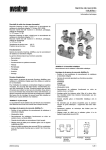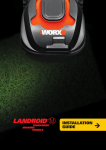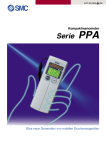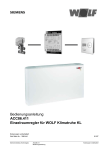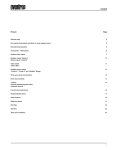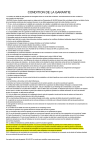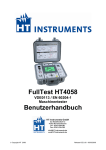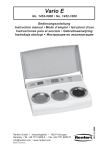Download Technical characteristics User Guide How to use your thermostat
Transcript
User Guide GB UFH – 24VAC Analogic thermostat - - How to caliber and limit the setting range. If your thermostat needs to calibrated, make these operations: Wired Analogic thermostat (24VAC) specially designed to control your Under Floor Heating managed by actuator (NC). Flush Mounting version, standard fixing with 60mm axes. Thermostat with silent output. Can drive directly the actuators, or can be connected to the UFH connecting boxes range. 1. Put a thermometer in the middle of the room at 1.5 Meter distance of the floor. 2. Wait 1 hour to be sure that your thermostat shows the correct temperature. 3. Remove the setting button by pressing gently outwards with a narrow screwdriver between the button and the cover. (pay attention to avoid setting button rotation) 4. Remove the internal wheel from the button. (Figure 1) 5. Put the internal wheel alone on the thermostat. (Figure 2) 6. You can now put the setting button on the thermostat, while making corresponds real room temperature (showed by the thermometer) and thermostat indexer. Technical characteristics Measured temperature precision 0.1°C Operating temperature 0°C - 50°C Setting temperature range 5°C - 30°C Regulation characteristics hysteresis (ON/OFF) Electrical Protection Class II - IP30 Power Supply Consumption 24VAC 50Hz ~ 0,5W TRIAC 24VAC 15W Max Output Fig. 1 Fig. 2 If your thermostat needs to be limited, make these operations: 1. Set the setting button on the middle of the new setting range. 2. Remove the setting button by pressing gently outwards with a narrow screwdriver between the button and the cover. 3. Remove the dial pins and put in the desired holes to limit the setting range of the thermostat. (Figure 3 et 4) 4. You can now put the setting button on the thermostat. 20°C 25°C How to use your thermostat Max Limitation Setting knob: The thermostat will follow the setting temperature all the time. Min Limitation LED Indicator Red: Heating indication. Fig. 3 Purmo DiaNorm Wärme AG Lierestraße 68 38690 Vienenburg Germany Tel: +49 5324 808-0 Fax: +49 5324 808-999 [email protected] / www.purmo.de Rettig Heating Sp. z o.o. ul. Przemysłowa, 44-203 Rybnik, Poland Biuro Handlowe ul. Rotmistrza Pileckiego 91, 02-781 Warszawa, Poland Tel: +48 22 643 25 20 Fax: +48 22 643 99 95 [email protected] / www.purmo.pl Fig. 4 20°C 10°C 15°C PPLIMP06664A Montage Anleitung D Analog Raumthermostat 24 VAC - - Kalibrierung und Begrenzung des Einstellbereiches Sollte eine Kallibrierung des Raumthermostaten erforderlich sein, gehen Sie wie folgt vor: Analoger Raumthermostat 24VAC für elektrothermische Stellantriebe stromlos geschlossen (NC) Unterputz Version Geräuschlos durch TRIAC Ausgang 1. Messen Sie die Raumtemperatur in der gewünschten Aufenthaltszone ca. 1,5 m über dem Boden 2. Um sicher zu gehen das der Raumthermostat seinen Beharrungszustand erreicht hat, darf der Sollwert ca. 1 Stunde nicht verändert werden. 3. Entfernen Sie vorsichtig den Stellknopf ohne die Einstellung zu verändern 4. Enfernen Sie den inneren Einsatz vom Stellknopf (Fig. 1) 5. Stecken Sie den inneren Einsatz wieder auf den Thermostaten (Fig. 2) 6. Stecken Sie den Stellknopf mit der gewünschten Temperatureinstellung wieder auf das Reglergehäuse Technische Daten Messgenauigkeit 0,1K Betriebstemperatur 0°C - 50°C Temperatureinstellbereich 5°C - 30°C Regelungsart 2-Punkt (xp=0,5K) Schutzart und -klasse IP30 / Schutzklasse II Betriebsspannung Leistung Schaltausgang 24VAC 50Hz ~ 0,5W TRIAC 230VAC 15W Fig. 1 Fig. 2 Wenn Sie den Einstellwert des Raumthermostaten begrenzen wollen, gehen Sie wie folgt vor: 1. Drehen Sie den Stellknopf in die Mitte des gewünschten Einstellbereiches 2. Entfernen Sie vorsichtig den Stellknopf 3. Entfernen sie die Begrenzungsstifte und stecken sie in die dafür vorgesehenen Löcher des gewünschten Einstellbereiches (Fig.4) 4. Stecken sie den Stellknopf wieder auf das Reglergehäuse 20°C Bedienung Max Begrenzung Stellknopf: Der Raumthermostat schaltet bei eingestelltem Sollwert LED Anzeige Rot: Heizbetrieb 25°C Min Begrenzung Fig. 3 Fig. 4 20°C 10°C 15°C



